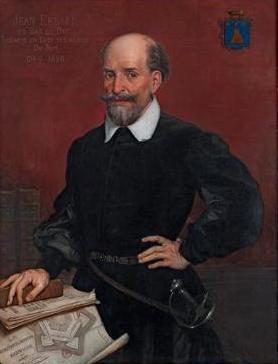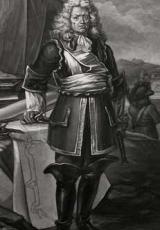Jean Errard

Jean Errard was a Protestant from Bar-le-Duc. After studying mathematics and geometry, he received training from Italian engineers at the service of the Duke of Lorraine, Charles III, where he was taken on in 1580. In 1583, the Duke gave him money to publish books (notably Le premier livre des instruments mathématiques mécaniques – First Book of Mechanical Mathematical Instruments). When his protector joined up with the Catholic League, Errard had to leave Lorraine in 1584 and took refuge in the Calvinist principality of Sedan, in the service of the La Marcks, Dukes of Bouillon, where he received the title of engineer of the Prince of Sedan. He continued work on the bastioned urban enclosure and then, in 1587, left for Jametz, as Sedan had decided to fortify the location’s defences. At the end of 1587, Charles III of Lorraine’s troops laid siege to Sedan, which capitulated on 24 July 1589. Jean Errard then took refuge there.
Errard made a reputation for himself with his long defence of Jametz (six months). The newly crowned King Henri IV heard of his exploits and called him into his service. He accompanied the sovereign on various campaigns to win back his kingdom, leading siege operations, building bastions and installing new fortifications.
He became a fortification engineer in Picardy and Île-de-France. Henri IV put him in charge of rehabilitating the defences at most of the fortresses. The King gave him the title of First Engineer, admitted him to the Royal Council and ennobled him in 1599. He built the citadels of Amiens and Verdun, modified the fortresses at Doullens in the Somme, Montreuil in the Pas-de-Calais, in Sedan and in Sisteron, where the front and side of the bastion form a right angle.
Jean Errard was the first to apply the principle of bastioned fortifications in France and to lay out their principles. His work earned him the title of "father of French fortifications”. His strategic thought was shaped by geometry: Errard used it to explain all the processes enabling him to lay out different polygons, whether regular or irregular, needed to fortify a site.
A major rule in his theoretical work lies in the fact that the defence of a site should depend more on infantry than on artillery, whose firepower at the time was not effective head-on.
His system comprised bastions, with room for two hundred infantrymen shooting head-on, and measuring some 70 metres wide. They had 30-metre-wide artillery batteries on each side – the principle behind his freestanding fortifications inspired Vauban.
His plans called for covert ways to defend the glacis (notion of "defilade"), as well as ravelins between the bastions to protect the curtain wall doors (notion of "flanking"). The main disadvantage of this defence system is that it presents bastions whose excessively sharp angular layout does not provide a full guarantee of safety for the besieged occupants.
Errard’s theoretical principles inspired the work of engineer Jean Sarrazin, Chevalier Deville (1595-1656), who refined the notion of flanking and divided up the covert ways, and Blaise Pagan (1607-1667), who inspired Vauban, promotor of the ravelin (evolved from of the barbican), for whom the bastion is the result of the broken, winding layout of the enclosure.
As an engineer, Jean Errard worked on hydraulic questions. In 1594, he designed a system for transforming the energy produced by a waterwheel using a shaft, eliminating the problems related to the ebb current. In 1600 he drew up plans for a chain control system for water pumps, later used by Arnold Deville.
Errard wrote “Premier Livre des instruments mathématiques et mécaniques”, released in Nancy in 1583, and “La Géométrie et pratique générale d'icelle” (Paris, 1594). He was also one of the first translators of Euclid and published “Les neufs premiers livres des Eléments d'Euclide traduits et commentez” in Paris in 1604 and 1605.
His greatest work is “La fortification démonstrée et réduicte en art”, whose first edition came out in Paris with a royal grant in 1600. The treatise’s success led to a second edition in 1604 and German editors released copies in Frankfurt in 1604, 1617 and 1622, as well as in Oppenheim in 1616 and 1617. His nephew, Alexis Errard, then undertook to reorganise the original edition based on his uncle’s notes and published a third edition in Paris in 1620.


